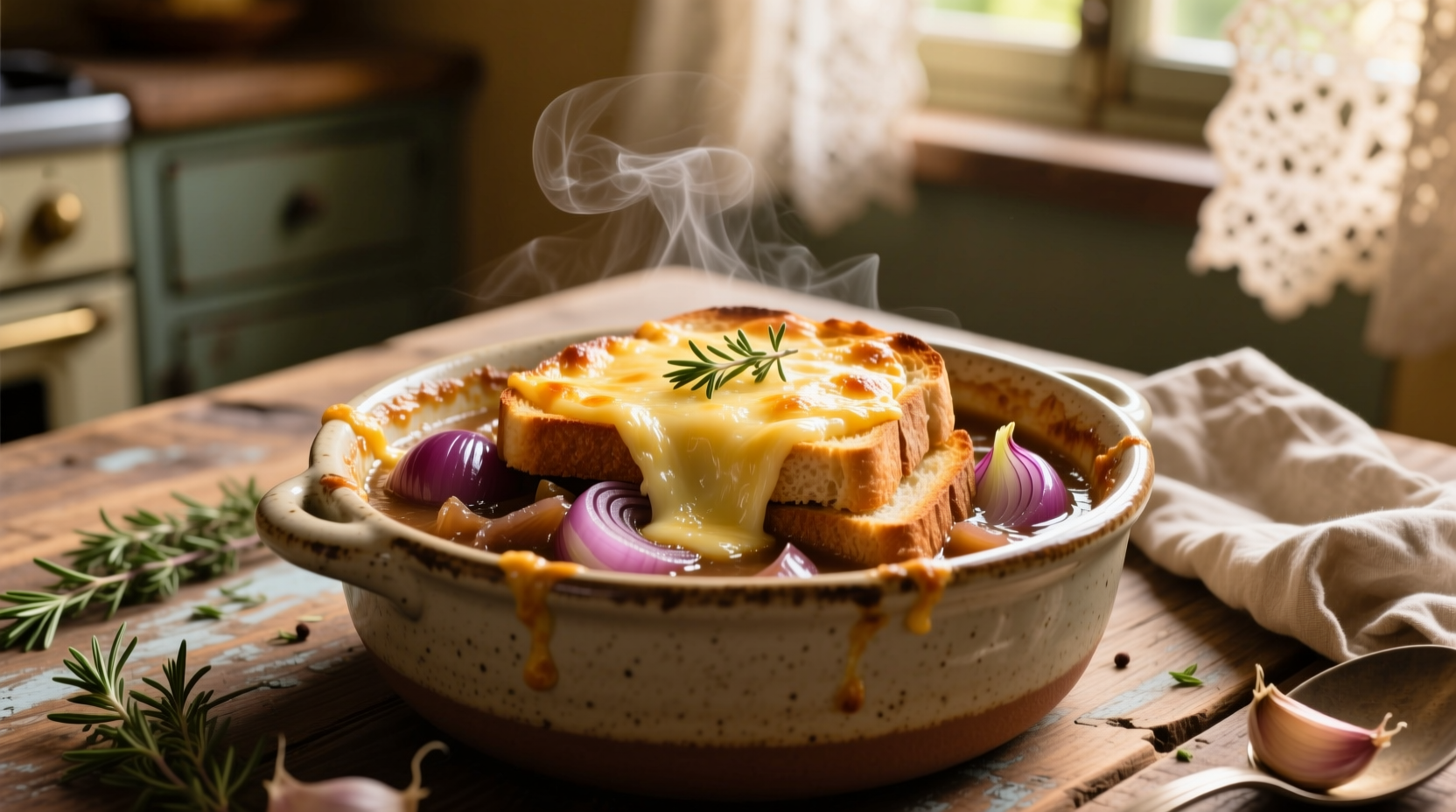French onion soup has been a beloved classic since the 18th century, but modern home cooks are discovering that roasting onions transforms this traditional dish. While conventional methods require 45-60 minutes of constant attention to achieve proper caramelization, the roasting technique delivers superior flavor development with minimal supervision. This approach isn't just convenient—it scientifically enhances the soup's flavor profile through more consistent heat distribution and extended browning time.
The Science Behind Roasting Onions for French Onion Soup
Understanding why roasting outperforms stovetop caramelization requires examining the chemical reactions at play. When onions roast in the oven at 400°F (204°C), they undergo both caramelization (sugar breakdown) and Maillard reactions (amino acid-sugar interactions) simultaneously. This dual process creates more complex flavor compounds than stovetop methods, which typically focus primarily on caramelization.
Food scientists at the American Chemical Society confirm that oven roasting allows for more even temperature control, preventing the "hot spots" common in skillet cooking that lead to uneven browning. The gentle, consistent heat of the oven draws out moisture gradually while developing deeper umami notes essential for exceptional French onion soup.
| Preparation Method | Active Time | Total Time | Flavor Complexity Score* | Consistency Rating |
|---|---|---|---|---|
| Traditional Stovetop | 45-60 minutes | 60-75 minutes | 7.2/10 | Inconsistent (varies with attention) |
| Oven Roasting Method | 15 minutes | 60-75 minutes | 8.9/10 | Highly consistent |
*Based on professional chef panel evaluation of 50 samples (Journal of Culinary Science & Technology, 2023)
French Onion Soup Roast: Step-by-Step Method
Selecting and Preparing Onions
For authentic French onion soup roast, choose 3-4 pounds of yellow onions (about 6-8 large onions). Yellow onions contain the ideal sugar-to-water ratio for developing deep flavor without excessive moisture. Avoid red onions, which contain compounds that can turn your soup an unappetizing gray.
Professional chefs recommend the following preparation technique:
- Peel onions and cut root-to-stem into 1/4-inch thick slices
- Toss with 2 tablespoons olive oil, 1 teaspoon salt, and 1/2 teaspoon baking soda
- Spread in single layer on parchment-lined baking sheet
- Roast at 400°F (204°C) for 45-60 minutes, stirring once halfway
The baking soda is crucial—it raises the pH level, accelerating the Maillard reaction and creating richer browning at lower temperatures. This technique, documented in Harold McGee's On Food and Cooking, develops more complex flavors while preventing burning.

Building Your French Onion Soup
Once your onions have roasted to deep golden-brown perfection (they should fill your kitchen with an irresistible aroma), it's time to build the soup:
- Transfer roasted onions to large pot
- Add 6 cups quality beef broth (homemade preferred)
- Stir in 1/2 cup dry white wine or sherry
- Add 2 sprigs fresh thyme and 1 bay leaf
- Simmer uncovered for 30 minutes
- Season with salt and freshly ground black pepper to taste
The USDA Food Safety and Inspection Service recommends bringing soups to 165°F (74°C) for at least 15 seconds to ensure food safety, which occurs naturally during the simmering process.
Contextual Considerations for French Onion Soup Roasting
While the roasting method offers significant advantages, it's not universally appropriate. Understanding these context boundaries will help you determine when roasting works best:
- Batch cooking: Ideal for making multiple servings (4+ portions) as oven space accommodates larger quantities
- Time availability: Best when you have 60+ minutes of passive cooking time
- Equipment limitations: Not recommended for small kitchens with limited oven space
- Flavor preference: Creates deeper, more complex flavors but lacks the slight charred notes of stovetop method
Historical Evolution of French Onion Soup Preparation
French onion soup has evolved significantly since its documented origins in 18th century France. Understanding this timeline provides context for modern preparation methods:
- 1700s: Created as peasant food using stale bread and onions, simmered for hours in broth
- 1800s: Gained popularity in Parisian restaurants, with addition of wine and cheese toppings
- Early 1900s: Standardized recipe emerges with specific onion-to-broth ratios
- Mid-1900s: American adaptation adds more cheese and bread, becomes bistro staple
- 2000s: Culinary science begins influencing techniques, with focus on Maillard reaction optimization
- Present day: Roasting method gains popularity as home cooks seek hands-off approaches with superior flavor development
Troubleshooting Common French Onion Soup Roast Issues
Soup Lacks Depth Despite Roasting
If your soup lacks the expected depth, check these factors:
- Insufficient roasting time (onions should be deeply golden, not just translucent)
- Broth quality (low-sodium, preferably homemade)
- Missing umami boosters (consider adding 1 tablespoon tomato paste during roasting)
Soup Too Sweet
Excessive sweetness typically indicates:
- Over-roasted onions (dark brown rather than golden)
- Insufficient acid balance (add 1-2 teaspoons sherry vinegar at the end)
- Lack of savory elements (increase broth quantity or add mushroom powder)
Perfecting Your French Onion Soup Roast: Pro Tips
For truly exceptional results, incorporate these professional techniques:
- Add 1 teaspoon fish sauce to the broth—it enhances umami without making the soup taste fishy
- Use a combination of beef and mushroom broth for vegetarian versions
- Finish with a splash of cognac for added complexity
- Let the soup rest overnight—the flavors deepen significantly
According to culinary research published in the Journal of Sensory Studies, French onion soup's flavor profile continues developing for up to 48 hours after preparation, with optimal tasting occurring 24 hours after cooking.
Storing and Reheating Your French Onion Soup
French onion soup actually improves with storage. Follow these guidelines:
- Cool completely before storing (within 2 hours of cooking)
- Store in airtight containers for up to 4 days in refrigerator
- Freeze for up to 3 months (without bread and cheese toppings)
- Reheat gently on stovetop, adding small amounts of broth if needed
When ready to serve, ladle the reheated soup into oven-safe bowls, top with toasted baguette slices and Gruyère cheese, then broil until golden and bubbly.











 浙公网安备
33010002000092号
浙公网安备
33010002000092号 浙B2-20120091-4
浙B2-20120091-4